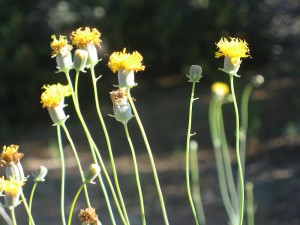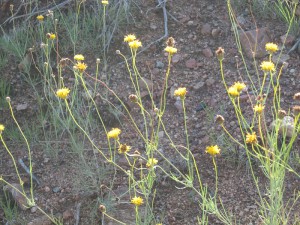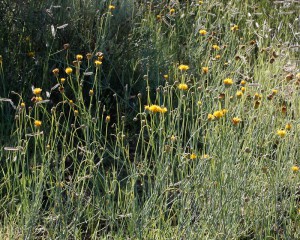Scientific name: Thelesperma megapotamicum
Family: Asteraceae
Common name: Cota, Indian tea, Hopi Tea, Navajo Tea, Zuni Tea, Greenthread
By Susan Bruneni
Photos: Beverley Spears
 Cota is an integral part of life in much of New Mexico. As its many common names indicate, it is widely used throughout the state. It is sold at the Santa Fe Farmers market as a pleasant-tasting beverage, has been used for centuries for a wide variety of medicinal purposes and is a key dye source for baskets and textiles. The genus Thelesperma is distinct to North America. (Some sources say there may be related species at the southern tip of South America, but to date this is not confirmed.)
Cota is an integral part of life in much of New Mexico. As its many common names indicate, it is widely used throughout the state. It is sold at the Santa Fe Farmers market as a pleasant-tasting beverage, has been used for centuries for a wide variety of medicinal purposes and is a key dye source for baskets and textiles. The genus Thelesperma is distinct to North America. (Some sources say there may be related species at the southern tip of South America, but to date this is not confirmed.)
A perennial member of the Aster family, Cota is also called greenthread because of its thread-like slender leaves. They are green, opposite and pinnate. Stems are long and slender. Flower heads are rayless and vary from 1/2 inch to 1 inch in size.
Cota is usually gathered when flowers open (summer and fall) and cut about three inches from the ground to allow the plant to regrow. It is found in dry or grassy areas in and around Santa Fe and can reach a height of up to three feet.
 On the Navajo and Hopi Reservations it grows by roadsides, on plains and mesas at an elevation of 4,000 to 7,500 feet. Commercial cultivation is underway near Gallup and Santa Fe.
On the Navajo and Hopi Reservations it grows by roadsides, on plains and mesas at an elevation of 4,000 to 7,500 feet. Commercial cultivation is underway near Gallup and Santa Fe.
Cota may be grown from seed, and plants are available in a few of our local nurseries (call in advance to find out availability. “We carry Cota from time to time,” says Mark Pennington of Agua Fria Nursery. “There are many different species growing in the area and it does very well in drier spots in Santa Fe gardens.” It also provides a splash of yellow to summer and fall gardens.
The tea is brewed by boiling in water for about five minutes. If it is being prepared for a dye, the rust color can be controlled by the amount used and the resulting strength. For a yellow dye, only the flowers are boiled. Cota dyes have been used for centuries in basket making and textile production. It is a treasured source of natural yellows and rust tones today.
 Leonora Curtin notes in Healing Herbs of the Upper Rio Grande that before tea or coffee were imported into New Mexico Cota was widely used as a beverage. She noted it was also used to reduce fevers and relieve skin ailments in babies. While at Sunday lunch at Santa Domingo (Kewa) Pueblo, she noticed several bundles on corn husk loops, hanging from the vigas inside the home. Her host told her it was a tea that was very good for the stomach.
Leonora Curtin notes in Healing Herbs of the Upper Rio Grande that before tea or coffee were imported into New Mexico Cota was widely used as a beverage. She noted it was also used to reduce fevers and relieve skin ailments in babies. While at Sunday lunch at Santa Domingo (Kewa) Pueblo, she noticed several bundles on corn husk loops, hanging from the vigas inside the home. Her host told her it was a tea that was very good for the stomach.
The commercial tea is available as Cota and Greenthread (Indian Tea). Honey or sugar may be added to the hot or cold brew.


